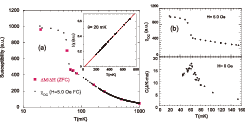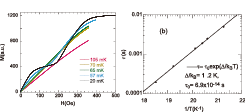Magnetic Ordering in the Ising Frustrated Spin-Chain Magnet NaCo(acac)3benzene
Y. Karaki, S. Nakatsuji, and Y. Uwatoko
Geometrical frustration in antiferromagnets has attracted much attention in recent years. The geometrical frustration destroys the conventional Néel state and tends to produce an exotic magnetic phase. Ising spin system with antiferromagnetic nearest-neighbor interactions on a triangular lattice is a simple frustrated system. A partially disordered antiferromagnetic (PDA) phase is a typical example of such exotic phases. [1]

Fig. 1. (a) Temperature dependence of DC χ (FC) and differential χ obtained from M-H curves. M-H curves are measured after zero field cooling. The inset shows the inverse of AC χ (220 Hz) of a needle-shaped sample at T> 200 mK. (b) Temperature dependence of the specific heat at zero field and DC χ at 5.0 Oe below 160 mK.

Fig. 2. (a) Magnetization curve for H// c at 20mK, 57mK, 65 mK and 105 mK. (b) Temperature dependence of the spin relaxation time.
A series of metal chelate compounds having the formula MIMII(acac)3benzene, where acac represents acetylacetonate, MI is Na+ or K+ and MII is divalent metal ion surrounded by the octahedron of oxygen atoms, have a trigonal crystal structure belonging to the space group P-31c with a = 10.24 Å and c = 11.95 Å [2]. Since the divalent metal ions form a hexagonal lattice, these compounds are possible candidates for studying the frustration on the triangular lattice.
Here we report on the results of the susceptibility(χ), magnetization and specific heat measurements using single crystals of NaCo(acac)3benzene [2]. ESR and χ measurements (T>2 K) show that Co2+ of NaCo(acac)3 benzene has the anisotropic g-factor gc= 8.12 and gperp= 1.41 for fictitious spin S=1/2. Figure 1(a) shows the temperature dependence of DC χ parallel to the c-axis at H= 5.0 Oe. The inset shows the inverse of AC χ(T) of a needle-shaped sample. Figure 1(b) shows the specific heat at zero field and DC χ at low temperatures. A long range ordering accompanied with a sudden increase of χ appears around 62 mK. Figure 2(a) shows the magnetization curve. Below 60 mK an anomaly of the M-H curve appears. A step-wise change of the magnetization becomes clear at 20 mK. At H~ 300 Oe the magnetic moment aligns fully with applied field. The plateau at 1/3 of full moment suggests a ferrimagnetic alignment of the ferromagnetic chains. The ferromagnetic intra-chain interaction JC/kB= -0.2 K and the antiferromagnetic inter-chain interaction J/kB = 0.05 K are deduced from the Weiss temperature 20 mK and the critical field 300 Oe. These results confirm the 1-D nature of NaCo(acac)3benzene. When a 1-D short-range order is well developed at low temperatures, each chain behaves like a magnetic moment and thus a magnetic ordering with two-dimensional character is expected. The mean field theory of a triangular Ising lattice predicts a step-like increase of χ at Tc from a paramagnetic phase to a PDA phase and no anomaly at Tc from the paramagnetic phase to the ferrimagnetic phase [2]. Thus the observed χ anomaly at 62 mK suggests the existence of the PDA phase around zero field. At the PDA phase, two thirds of chains order into an antiferromagnetic alignment and the resultant chain is incoherent with other chains. Since the molecular fields of the incoherent chain are canceled, the magnetic response of single chain is expected in the PDA phase. Figure 2(b) shows temperature dependence of the spin relaxation time obtained from the frequency dependence of AC χ. The thermal activation process with the gap energy Δ/kB= 1.2 K is observed. However, obtained gap energy is about 6 times larger than estimated value using Δ=4S2Jc given by Glauber for a ferromagnetic Ising chain [3]. The simple chain model in the PDA phase cannot explain the observed spin relaxation well enough. Further microscopic measurements are necessary to clarify the ordered phase and the spin relaxation mechanism.
References
- [1] M. Mekata, J. Phys. Soc. Jpn. 42, 76 (1977).
- [2] Y. Karaki, K. Kuga, K. Kimura, S. Nakatsuji , K. Matsubayashi, and Y. Uwatoko, submitted to J. Phys. Soc. Jpn.
- [3] R. J. Glauber, J. Math. Phys. 4, 294 (1963)
